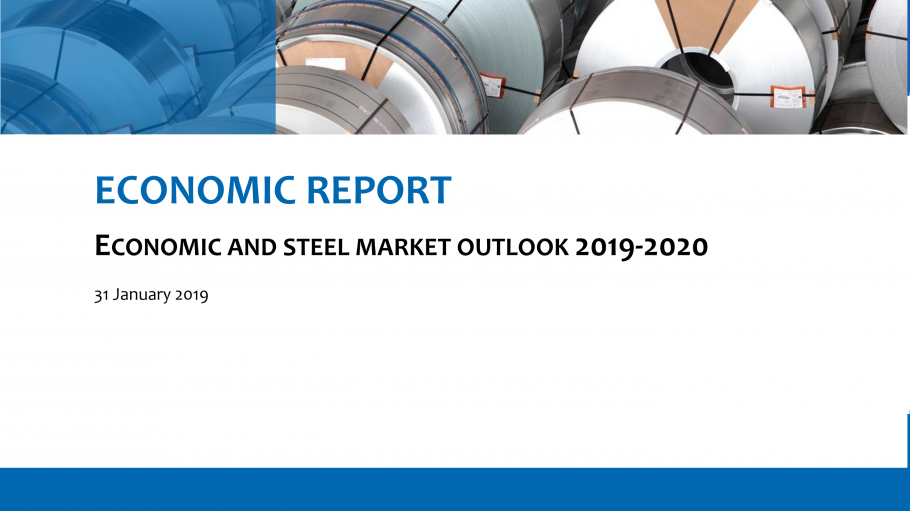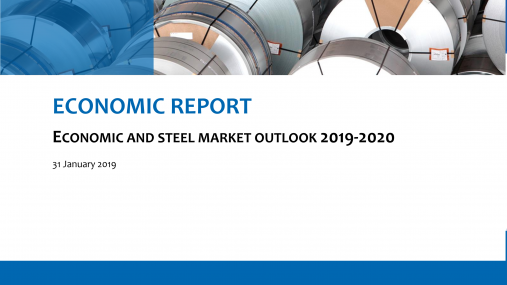
Press releases » Still rising imports collide with slowing steel demand growth
Still rising imports collide with slowing steel demand growth
Downloads and links
Recent updates

Brussels, 31 January 2019 – The EU steel market is estimated to have risen by 2.6% in 2018. The increase in steel demand mainly benefitted third country suppliers, owing to a rise of 12.3% in imports. By contrast, European producers barely gained from domestic growth, shipping just 0.6% more steel to the EU market.
“The sharp increase in imports in the second half of 2018 is proof that in spite of the justified imposition of preliminary safeguard measures by the EU Commission last July the EU market is still under siege”, said Axel Eggert, Director General of the European Steel Association (EUROFER). “Market access to other regions has been blocked by protectionist measures in those places, thereby leading to a continued diversion of steel to the EU market”.
“This diversionary trend is expected to continue in 2019 – especially as the safeguard’s quota size will be increased to by 5% in February and by another 5% in July’, added Mr Eggert. “This ‘relaxation’ could occur even as 2019 EU steel demand is forecast to be flat and underpins even greater uncertainty for steel producers”.
EU steel market overview
EU apparent steel consumption grew by 2.6% year-on-year in the third quarter of 2018 and amounted to 38 million tonnes. Quarterly apparent steel consumption had, on average, been around 43 million in the first half of the year. Lower consumption in the third quarter can be explained from the usual seasonal slowdown in manufacturing and construction activity and some destocking in the supply chain.
Estimates for the fourth quarter of 2018 show a further deceleration in year-on-year growth in apparent steel consumption and again a lower quarterly volume as a result of seasonal destocking in the final quarter of the year.
EU steel market fundamentals are expected to remain moderately positive. Nevertheless, apparent steel consumption growth is forecast to slow down to only 0.5% in 2019 followed by 1.2% in 2020, less than one-third of the compound annual growth rate of apparent steel consumption over the period 2014-2018.
This very modest growth scenario in combination with a global steel market that is suffering from overcapacity, slowing demand – and as a consequence a flurry of protectionist measures – has the potential to develop into a major threat for EU market stability.
EU steel-using sectors
Having grown at rather vigorous quarterly rates in 2017 and the first half of 2018, production growth in the EU steel-using sectors slowed down in the third quarter of 2018. The growth moderation was particularly evident in the automotive sector.
In contrast, the only large steel-using sector that did not witness a growth deceleration was the construction industry. Total output growth in the EU’s steel-using sectors is estimated to have amounted to 3.1% in 2018.
The growth trend in production activity over 2018 confirms that EU steel-using sectors have entered the late stage of the current business cycle. While economic fundamentals will remain mildly positive, actual growth rates of production activity will slow down in 2019 and 2020.
Output in EU steel-using sectors is forecast to grow by 1.5% in 2019 and by 1.7% in 2020.
EU economic context
The EU economy slowed considerably in the third quarter of 2018, recording its weakest growth performance in four years. GDP data and forward-looking indicators appear to suggest that the EU economy has entered the late-cycle phase of the rebound that started in 2014.
Economic fundamentals should remain supportive to continued, but slowing, growth in domestic demand and, to a lesser extent to international trade, in 2019 and 2020.
Nevertheless, several factors could lead to a faster and more severe reversal of economic conditions than currently expected and could even cause the EU economy to slide into an early recession.
The greatest risks stem from a global economic context which has become more uncertain due to rising protectionism, potentially leading to a further escalation of trade tensions between the US and its trading partners.
Other risks include increased volatility in financial markets and the related vulnerability, in particular, of emerging economies. This volatility could lead to a deterioration in financial conditions, as well as geopolitical instability. All in all, the balance of risks has clearly shifted to the downside in recent months.
EUROFER’s first quarter 2019 forecast for EU GDP growth is 1.7% in both 2019 and 2020.
Contact
Charles de Lusignan, Spokesperson and head of communications, +32 2 738 79 35, (charles@eurofer.be)
About the European Steel Association (EUROFER)
EUROFER AISBL is located in Brussels and was founded in 1976. It represents the entirety of steel production in the European Union. EUROFER members are steel companies and national steel federations throughout the EU. The major steel companies and national steel federations in Switzerland and Turkey are associate members.
About the European steel industry
The European steel industry is a world leader in innovation and environmental sustainability. It has a turnover of around €170 billion and directly employs 330,000 highly-skilled people, producing on average 160 million tonnes of steel per year. More than 500 steel production sites across 22 EU Member States provide direct and indirect employment to millions more European citizens. Closely integrated with Europe’s manufacturing and construction industries, steel is the backbone for development, growth and employment in Europe.
Steel is the most versatile industrial material in the world. The thousands of different grades and types of steel developed by the industry make the modern world possible. Steel is 100% recyclable and therefore is a fundamental part of the circular economy. As a basic engineering material, steel is also an essential factor in the development and deployment of innovative, CO2-mitigating technologies, improving resource efficiency and fostering sustainable development in Europe.

Download files or visit links related to this content
Strasbourg, 07 October 2025 – The new trade measure presented today by the European Commission is a long-awaited proposal to forcefully defend the European steel sector, in full respect of WTO rules, from unfair imports flooding the EU market due to massive global overcapacity. The provisions unveiled by the Commission respond to the needs of the sector and represent a real lifeline for EU steelmakers and steelworkers. The European Parliament and the Council should therefore adopt it as a matter of urgency to enable its entry into force at the beginning of 2026, says the European Steel Association (EUROFER).
Brussels, 01/10/2025
With Europe’s steel industry at breaking point, industriAll Europe and the European Steel Association (EUROFER) held an emergency steel social summit to demand urgent action. Ahead of the announced Commission proposal addressing the impact of global steel excess capacity on the EU steel market, due by mid-October, the European social partners are united in calling for robust and effective trade measures. They also insist on fast and urgent implementation of the EU Steel and Metals Action Plan, especially concerning energy prices and demand. Maintaining the level of political ambition as promised in the EU Steel and Metals Action Plan is essential to restore steel’s competitiveness and save its green transition as well as steelworkers’ jobs across Europe.
Brussels, 19 September 2025 – Following today’s meeting between Commissioner for Trade Maroš Šefčovič and a delegation of European steel CEOs on the global steel crisis and the challenges facing the EU steel industry amid massive decarbonisation investments: